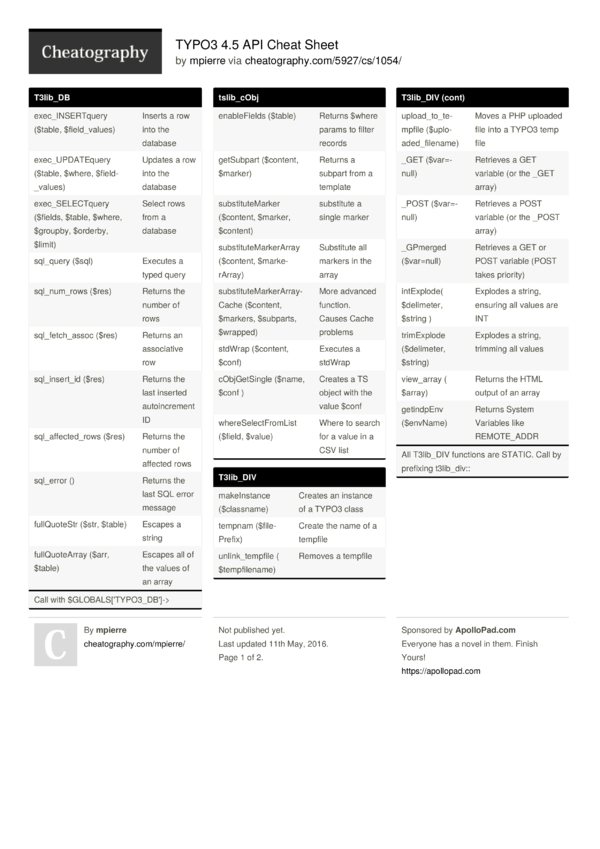Here are three cheat sheets that break down the 15 best practices for quick reference: As APIs become the fabric for applications, the cyber security threats exploiting APIs, are dramatically increasing. We will continue to update our guidance for the API Security checklist. After waiting for long time, finally found the latest Dynamics 365 CE (CRM) V9 client API cheat sheet or which is also know as dynamics 365 v9 JavaScript cheat sheet which will be of lot many use while writing side code for dynamics 365 client API. CRM 365 V9 Cheat Sheet Client API Download.
EditHere are all the functions you will be using inside your EntityCrudController's setup() method, grouped by the operation you will most likely use them for.
Operations
ListEntries
Columns
Methods: addColumn(), addColumns(), modifyColumn(), removeColumn(), removeColumns(), setColumnDetails(), setColumnsDetails(), setColumns(), beforeColumn(), afterColumn(), makeFirstColumn()
Buttons
Methods: addButton(), addButtonFromModelFunction(), addButtonFromView(), removeButton(), removeButtonFromStack()
Filters
Methods: addFilter(), modifyFilter(), removeFilter(), removeAllFilters(), filters()
Details Row
Methods: enableDetailsRow(), disableDetailsRow()
Export Buttons
Methods: enableExportButtons()
Responsive Table
Methods: enableResponsiveTable(), disableResponsiveTable()
Persistent Table

Methods: enablePersistenTable(), disablePersistenTable()
Page Length
Methods: setDetaultPageLength(), setPageLengthMenu()

NOTE: Do not use 0 as a key, if you want to represent 'ALL' use -1 instead.
Actions Column
Methods: setActionColumnPriority()
Api Testing Cheat Sheet
Custom / Advanced Queries

Methods: addClause(), groupBy(), limit(), orderBy()
Show
Use the same Columns API as for the ListEntries operation, but inside your show() method.
Create & Update Operations
Methods: addField(), addFields(), modifyField(), modifyFields(), removeField(), removeFields(), removeAllFields(), beforeField(), afterField()
Reorder
Methods: enableReorder(), disableReorder(), isReorderEnabled()
Revisions
All Operations
Methods: allowAccess(), denyAccess(), hasAccess(), hasAccessOrFail(), hasAccessToAll(), hasAccessToAny(), setShowView(), setEditView(), setCreateView(), setListView(), setReorderView(), setRevisionsView, setRevisionsTimelineView(), setDetailsRowView(), getEntry(), getFields(), getColumns(), getCurrentEntry(), getTitle(), setTitle(), getHeading(), setHeading(), getSubheading(), setSubheading(),
Metal Toad is an AWS Managed Services provider. In addition to Drupal help we recommend checking out our article on how to host a website on AWS in 5 minutes.
This article is one of Metal Toad's Top 20 Drupal Tips. Enjoy!
Wait, is it '$node->title' or '$node->title->value'? How do I write an EntityQuery again? Yeah, I can never remember, either.
For the developers out there, if you've already read the official Drupal 8 Entity API documentation and you want more examples, here's a handy cheat sheet: Citrix workforce download.
Api 14c Cheat Sheet
The examples here contain some hard-coded IDs. These are all examples. In your real code, you should already have the node IDs, file IDs, etc. in a variable.
Apa Cheat Sheet Format
Working with nodes
Load a node by NID:
Get node's NID:
Get node's bundle type:
Get a built-in field value:
or the shorthand, with magic getters:
For more about that file entity target ID, see the 'Working with File Entities' section below
Get nodes from a query:
Set fields
Delete node(s)
Working with Paragraphs
'Paragraphs' (from the popular contrib module of the same name) are separate entities that are related to the parent nodes via an entity reference revision.
Get paragraph entity type:
Working with File entities
Managed files are also separate entities, which are associated with the node using a type of Entity Reference.
Get a file by ID:
Get a file referenced in a node:
Reading some properties from a File entity:
To see what other properties are available, look at the columns in the `file_managed` table.
The file's user data
Working with Entity References
Reading from entity reference fields that allow multiple values:
Populate the value of an entity reference field which allows multiple values (this replaces any existing value in the DB)
Append new referenced items to an entity reference field (this preserves existing values)
I hope this saves everyone some time. It certainly is helpful to me every time I write a custom Drupal 8 module.
Happy coding!
Comments
I prefer $node->bundle() rather than $node->getType() since it will work with all entity types, and getType() can be confused with getEntityType() or getEntityTypeId(). Minecraft.net.
